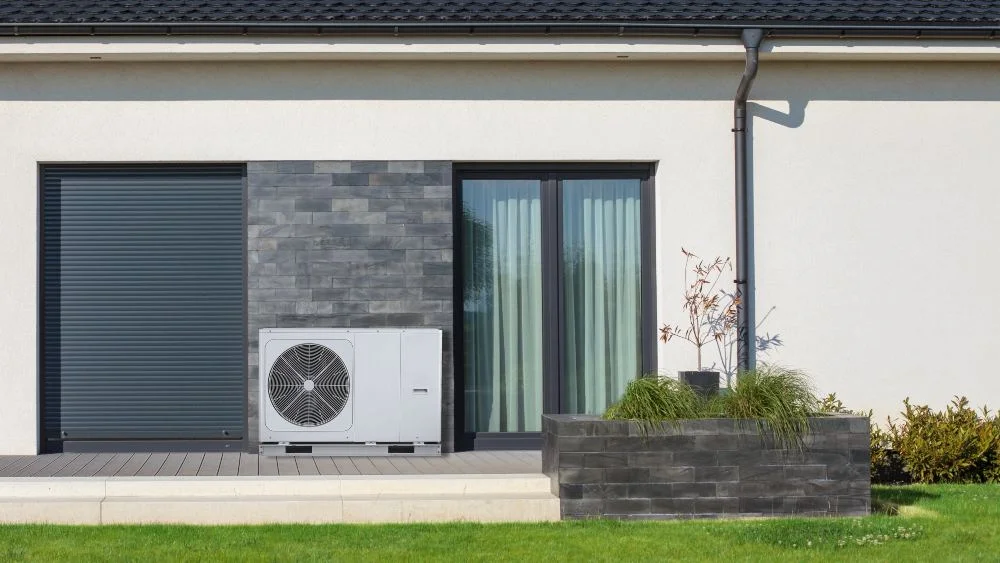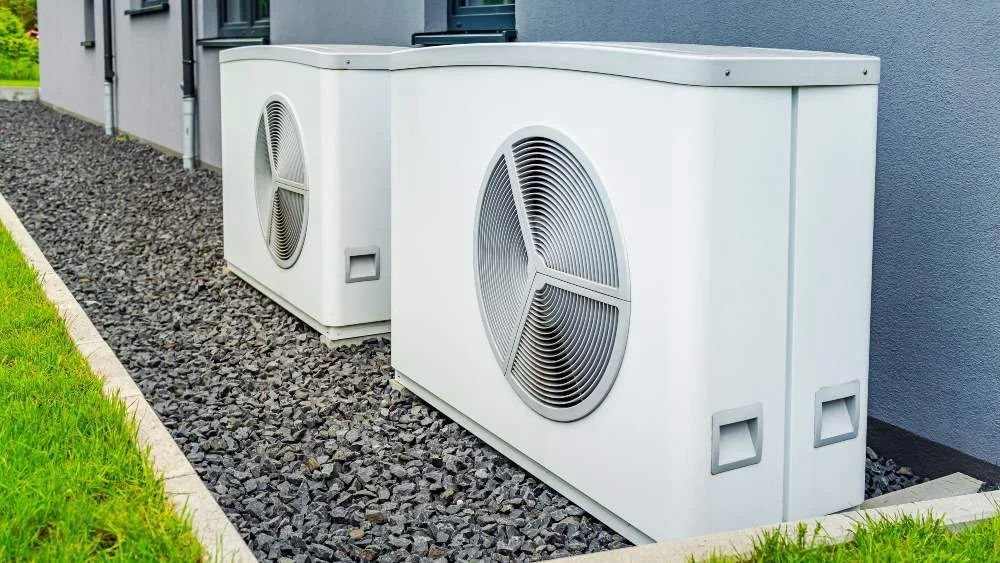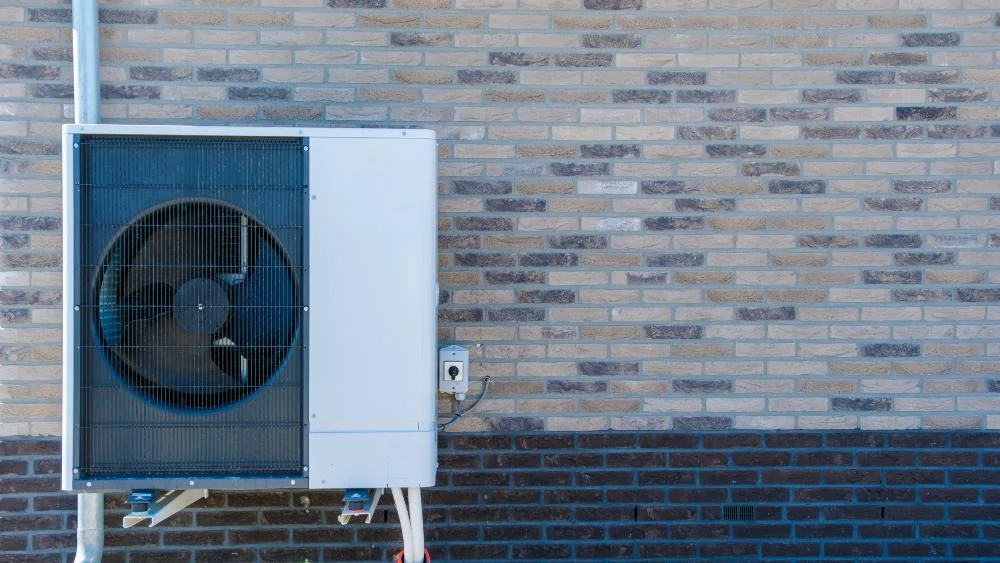
Key Takeaways
- Air-source heat pumps can both heat and cool your home, providing year-round comfort.
- These systems are highly efficient because they transfer heat instead of generating it, reducing energy usage.
- There are two main types of air-source heat pumps: Ducted units (can be installed with existing ducts) and ductless mini-splits (ideal for homes without ductwork).
HVAC systems are essential to maintain your desired home climate. However, heating and cooling units are among the highest energy consumers in your household.
With their ability to significantly reduce energy consumption and lower carbon emissions, air-source heat pumps offer an eco-friendly alternative to conventional HVAC units. They provide both heating and cooling, making them a reliable choice for year-round comfort.
This blog will explore how air-source heat pumps function, discuss their key components, discuss modern innovations, and highlight the various types available to help you decide if this eco-friendly solution is right for your home. Whether you’re looking to upgrade your HVAC system or simply want to learn more about sustainable heating and cooling options, this guide has you covered!
What is an Air-Source Heat Pump?
An air-source unit is an HVAC system that can heat and cool your home. It is also referred to as an air-to-air source heat pump. In summer, it extracts heat from the indoor air and transfers it outside to cool your home. Contrary to traditional heating systems, it does not burn fuel to generate heat, which makes it a more energy-efficient and environmentally friendly option.
Basic Heat Pump Components
Air-source heat pumps consist of two systems: an outdoor unit and an indoor unit. The outdoor unit includes a compressor, outdoor coil, and expansion valve. Meanwhile, the indoor unit contains a fan and an indoor coil.
- Compressor: It compresses the refrigerant gas, increasing its pressure and temperature to allow it to move throughout the system.
- Evaporator Coil: It is located in the indoor unit and consists of a triangular arrangement of pipes and fins made from copper or aluminum. The evaporator coil allows the refrigerant to flow through its pipes, where it absorbs heat from the air inside the home. During the heating process, it expels heat into your home.
- Condenser Coil: It is similar in design and material to the evaporator coil but serves a reverse function. Found in the outdoor unit of the air conditioner, it expels the heated air from your home. In the heating process, the condenser coil absorbs heat from the outside air.
- Refrigerant: It is a substance that absorbs the heat from the air and runs within the copper coils in the heat pump.
- Expansion Valve: It regulates the flow of refrigerant and reduces its pressure and temperature to meet the temperature requirements.
- Reversing Valve: This component changes the flow of the refrigerant so that the heat pump can heat and cool your home simultaneously.
Related: All You Need to Know About Air Conditioner Components
Innovations in Modern Air-Source Heat Pumps
The modern air-source heat pumps are very efficient due to these technological advancements:
- Equipped with electronic and thermostatic expansion valves, they provide more precise control over the refrigerant flow inside them.
- The coil design has been improved so that they are thicker in order to support better dehumidification.
- The inverter technology in modern heat pumps promotes seamless switching between low and high speeds, helping you save energy.
- The variable-speed blowers reduce the airflow during part-load conditions to help compensate for blocked ducts, dirty filters, and coils.
Related: Inverter Air Conditioner: A Comprehensive Buyer’s Guide
How Does the Air-Source Heat Pump Heat and Cool Your Home?

Air-source heat pumps provide a versatile solution for both heating and cooling your home, adapting seamlessly to seasonal changes.
Cooling Process
Here’s how the cooling process works:
- The heat in your home is absorbed by the refrigerant in the indoor unit.
- After taking in the heat, the refrigerant transforms from a liquid to a gas and enters the compressor.
- The compressor pressurizes the refrigerant, which raises its temperature and turns it into gas.
- At high pressures, the refrigerant’s energy level is higher than the outside air, allowing it to release heat outdoors and condense back into a liquid.
- Once the heat is released outside, the resulting cool air is circulated into your home, and the cycle continues.
Heating Process
In the heating process, the cycle is reversed. Heat pumps are effective at capturing the heat from the air to warm up your home. Here’s how the process works:
- Heat is extracted from the outside and is blown over the heat exchanger of the outdoor unit.
- This heat causes the refrigerant in the heat pump to turn into a gaseous substance.
- The gas is moved to the compressor, where its pressure is increased.
- The refrigerant is then passed over the internal heat exchanger, where it releases the heat and returns to its liquid state.
- This heat is transferred throughout your home through ductwork or an indoor air handler.
- The heating cycle continues until your desired temperature is reached.
Types of Air-Source Heat Pumps
Heat pumps can be categorized into two main types: ducted and ductless, each with its subtypes.
Ducted Heat Pumps
Ducted air-source heat pumps consist of an outdoor unit and an indoor unit. They are connected to a series of ducts and vents that distribute air inside the home. Compared to traditional systems like furnaces, these types of heat pumps reduce electricity consumption by up to 65%.
You can pair your ducted heat pumps with smart thermostats for central HVAC, further boosting energy efficiency. These smart devices allow remote control of your heat pump via smartphone and have a plethora of smart features to enhance your comfort and convenience.
Equip your HVAC system with smart features and achieve the perfect balance between comfort & savings.
Learn more
These systems can further be categorized into five main types:
- Split Systems
Split systems consist of two main components: an indoor unit that houses the evaporator coil and fan and an outdoor unit that contains the condenser and compressor. The indoor unit is connected to the home’s ductwork, distributing cooled or heated air through supply ducts and collecting return air via return ducts.
- Packaged Systems
In a packaged system, all the heating and cooling components are combined into a single unit, usually located outside the home on a concrete slab or rooftop. This system delivers conditioned air via ductwork that passes through the wall or roof into the home. Packaged systems are space-efficient and are often used in homes with limited indoor space for a furnace or air handler.
- Single Zone & Multi-Zone Ducted Heat Pumps
Single-zone ducted systems are controlled by one thermostat, which regulates the temperature of the entire home.
In multi-zone ducted systems, your house is divided into various zones so different areas can be heated or cooled independently. This is achieved by installing dampers and louvers against each duct for each zone. You can have mutiple thermostats installed in each area. The modern approach is to have a multi zone thermostat installed in a main location with sensors in other areas.
Related: What is an HVAC Zoning System?
- Short-Run Ducted Heat Pumps
These ducted heat pumps use ductwork, but only in certain small parts of your home. They are usually paired with ductless heat pumps to provide efficient heating throughout your home.
Ductless Heat Pumps
A ductless heat pump, also known as a mini-split heat pump, operates without needing ducts or vents. It has an outdoor handler that is connected to one or more individual indoor units. This system provides hot or cool air directly where required via indoor air handlers.
Related: Ducted vs. Ductless Air Conditioning Systems
To get the most out of your ductless systems, you can always invest in smart mini-split thermostats. With advanced features like scheduling, location-based automation, and real-time energy monitoring, you can maintain optimal comfort in your home while reducing energy consumption and costs.
Your best choice to make any mini-split, window,
or portable AC smart. Enhance your comfort and savings.

Types of ductless heat pumps:
- Single-Zone Mini-Split System
In a single-zone mini-split system, one outdoor condenser is paired with a single indoor head to control the temperature in a specific room or area. The indoor unit is usually placed in a central area of your home or a room that is most used by the occupants.
- Multi-Zone Mini-Split System
Multi-zone mini-split systems, on the other hand, allow multiple indoor heads to be connected to a single outdoor unit, providing customized temperature control in different rooms throughout your home. They can be placed strategically around your home according to your convenience.
Factors to Consider When Installing Air-Source Heat Pump
When installing your air-source system, you need to carefully consider several factors before choosing one that will suit your home and preferences.
Climate
It is essential to check your local climate before installing your heat pump. Heat pumps are well-equipped to handle moderate temperatures. “However, do not write off air-source heat pumps just because you live in a cold climate. Recent technological developments have made them suitable for it. Cold-climate heat pumps are designed to function successfully in temperatures that would have been too difficult for previous models to handle,” says Francis Kaspar, an HVAC technician at The Chill Brothers.
Energy Efficiency Ratings
A heat pump’s heating mode efficiency is measured by the Heating Seasonal Performance Factor (HSPF). It is measured by the total heat provided over a season divided by the energy consumed.
In cooling mode, it is gauged by the Seasonal Energy Efficiency Ratio (SEER), which is a measure of the total heat removed over a cooling season divided by the total electricity consumed,
The higher the HSPF and SEER rating, the greater the energy efficiency and reduced utility expenses. Since January 2023, new efficiency standards (HSPF2 and SEER2) have been introduced to more accurately account for airflow resistance in duct systems. For instance, a unit previously rated at 15 SEER would now be rated at 14.3 SEER2, while an 8.8 HSPF would translate to a 7.5 HSPF2 heating efficiency.
Cost
When choosing a heat pump for your home, consider both the initial cost and long-term operating expenses. Whole-home models with higher efficiency ratings tend to have a higher upfront price compared to mini-split systems designed for smaller spaces.
Size and Capacity
Size and capacity are crucial when selecting the right heat pump for your home. An undersized unit will struggle to maintain comfort, while an oversized one cycles too frequently, reducing efficiency and wearing down components. Heat pump capacity is measured in British thermal units per hour (Btu/hr) or tons, with 1 ton equaling 12,000 Btu/hr.
Air-Source Heat Pump Benefits

If you’re still wondering why you should choose air-source heat pumps for your home, then here is a list of benefits for you:
- Heat pumps use minimal energy by transferring heat from the air rather than generating it, making them highly efficient for both heating and cooling.
- These units run on electricity and eliminate the need to burn fossil fuels like oil or propane directly. Compared to gas furnaces, this helps lower your carbon emissions by up to 53%. The exact amount will vary depending on how your electricity is produced.
- Traditional heating systems struggle to maintain consistent temperatures in your home. With furnaces, you typically experience a cycle where they heat your home, then shut off, causing the temperature to drop significantly before turning on again. In contrast, modern heat pumps are much more effective at regulating temperature and humidity. They provide consistent, quiet comfort throughout the year, maintaining even temperatures.
- The ductless heat pump is an excellent solution for providing climate control in areas of your home that lack it, such as a newly finished attic. They are also ideal for homes without existing ductwork since they are much simpler to install. Even if you primarily install them for cooling, you might be pleasantly surprised by their heating efficiency as well, which can help reduce the time you need to use your main heating system.
The Takeaway
Air-source heat pumps provide year-round comfort while reducing energy costs. With advancements in cold-climate technology, these systems now perform reliably even in extreme temperatures, making them a viable option for homes and buildings in various climates. Whether you’re looking to upgrade your system, reduce your carbon footprint, or save energy, these heat pumps present a smart, sustainable choice for the future of home comfort.
Frequently Asked Questions
How Much Do Heat Pumps Cost?
The cost to install a new air-source system ranges between $4,000 to $8,000, depending on the unit's size. While initial expenditures may appear hefty, "Keep an eye out for federal tax credits, state rebates, and municipal incentives for installing energy-efficient devices like heat pumps. These might lower the initial outlay and alleviate the financial burden on you. To make sure you are receiving all the financial assistance possible, check the website of your neighborhood energy supplier or speak with your installer," says Kasper.
Eligibility for it usually depends on certain factors, such as efficiency ratings, installation specifics, and any other requirements the utility company may have set to offer rebates. For example, in Massachusetts, you can get a $10,000 rebate for installing an air-source heat pump in a whole home, and in a partial home, you can avail yourself of $1,250 per tonne up to $10,000. You can also pair it with a smart thermostat eligible for a rebate.
Are Air-Source Heat Pumps Loud?
Contrary to common assumption, air-source heat pumps are quiet. Most systems work at 50-60 dB, which is comparable to light rain. Indoor units are considerably quieter, rating around 25 dB, and are considerably quieter compared to traditional HVAC systems.
Is an Air-Source Heat Pump the Same as Air Conditioning?
While both cool your home in summer, an air-source heat pump can also heat it in winter by reversing the process. An AC only cools, but a heat pump works all year round.
Are There Any Disadvantages of Using an Air to Air Heat Pump?
High upfront costs and reduced efficiency in extremely cold temperatures are some of the drawbacks of air-source heat pumps. In very cold regions, a backup heating system may also be needed.








